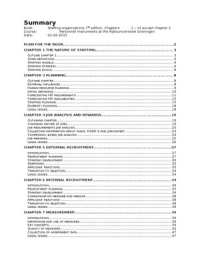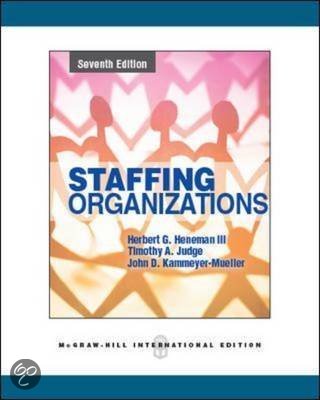Summary
Book: Staffing organizations 7th edition. Chapters 1 – 14 except chapter 2
Course: Personnel Instruments at the Rijksuniversiteit Groningen
Date: 02-06-2015
PLAN FOR THE BOOK......................................................................................2
CHAPTER 1 THE NATURE OF STAFFING.............................................................3
OUTLINE CHAPTER 1............................................................................................................. 3
SOME DEFINITIONS............................................................................................................... 3
STAFFING MODELS................................................................................................................ 4
STAFFING STRATEGY............................................................................................................. 6
STAFFING ETHICS................................................................................................................. 8
CHAPTER 3 PLANNING....................................................................................8
OUTLINE CHAPTER................................................................................................................ 8
EXTERNAL INFLUENCES.......................................................................................................... 8
HUMAN RESOURCE PLANNING.................................................................................................9
INITIAL DECISIONS.............................................................................................................. 10
FORECASTING HR REQUIREMENTS......................................................................................... 11
FORECASTING HR AVAILABILITIES.......................................................................................... 13
STAFFING PLANNING........................................................................................................... 15
DIVERSITY PLANNING.......................................................................................................... 18
LEGAL ISSUES................................................................................................................... 18
CHAPTER 4 JOB ANALYSIS AND REWARDS......................................................19
OUTLINING CHAPTER........................................................................................................... 19
CHANGING NATURE OF JOBS................................................................................................. 19
JOB REQUIREMENTS JOB ANALYSIS.......................................................................................... 20
COLLECTING INFORMATION ABOUT TASKS, KSAO’S AND JOBCONTEXT...........................................23
COMPETENCY-BASED JOB ANALYSIS........................................................................................24
JOB REWARDS................................................................................................................... 25
LEGAL ISSUES................................................................................................................... 26
CHAPTER 5 EXTERNAL RECRUITMENT............................................................27
INTRODUCTION.................................................................................................................. 27
RECRUITMENT PLANNING..................................................................................................... 27
STRATEGY DEVELOPMENT..................................................................................................... 30
SEARCHING....................................................................................................................... 32
APPLICANT REACTIONS........................................................................................................ 33
TRANSITION TO SELECTION................................................................................................... 34
LEGAL ISSUES................................................................................................................... 34
CHAPTER 6 INTERNAL RECRUITMENT.............................................................34
INTRODUCTION.................................................................................................................. 34
RECRUITMENT PLANNING..................................................................................................... 35
STRATEGY DEVELOPMENT..................................................................................................... 36
COMMUNICATION MESSAGE AND MEDIUM................................................................................38
APPLICANT REACTIONS’....................................................................................................... 38
TRANSITION TO SELECTION................................................................................................... 38
LEGAL ISSUES................................................................................................................... 39
CHAPTER 7 MEASUREMENT...........................................................................39
INTRODUCTION.................................................................................................................. 39
IMPORTANCE AND USE OF MEASURES......................................................................................39
KEY CONCEPTS.................................................................................................................. 39
QUALITY OF MEASURES....................................................................................................... 42
COLLECTION OF ASSESSMENT DATA........................................................................................47
LEGAL ISSUES................................................................................................................... 47
,CHAPTER 8 EXTERNAL SELECTION 1..............................................................48
INTRODUCTION.................................................................................................................. 48
PRELIMINARY ISSUES........................................................................................................... 48
INITIAL ASSESSMENT METHODS............................................................................................. 50
LEGAL ISSUES................................................................................................................... 52
CHAPTER 9 EXTERNAL SELECTION 2..............................................................53
INTRODUCTION.................................................................................................................. 53
SUBSTANTIVE ASSESSMENT METHODS.....................................................................................53
CHOICE OF SUBSTANTIVE ASSESSMENT METHODS......................................................................55
DISCRETIONALRY ASSESSMENT METHODS................................................................................55
CHAPTER 10 INTERNAL SELECTION................................................................56
INTRODUCTION.................................................................................................................. 56
PRELIMINARY ISSUES........................................................................................................... 56
INITIAL ASSESSMENT METHODS............................................................................................. 56
SUBSTANTIVE ASSESSMENT METHODS.....................................................................................57
DISCRETIONARY ASSESSMENT METHODS..................................................................................58
CHAPTER 11 DECISION MAKING.....................................................................58
INTRODUCTION.................................................................................................................. 58
CHOICE OF ASSESSMENT METHOD......................................................................................... 58
DETERMINING ASSESSMENT SCORES.......................................................................................59
HIRING STANDARDS AND CUT SCORES....................................................................................59
METHODS OF FINAL CHOICE................................................................................................. 61
DECISIONS MAKERS............................................................................................................ 61
CHAPTER 12 FINAL MATCH............................................................................61
INTRODUCTION.................................................................................................................. 61
EMPLOYMENT CONTRACTS.................................................................................................... 61
JOB OFFERS...................................................................................................................... 62
JOB OFFER PROCESS........................................................................................................... 63
NEW EMPLOYEE ORIENTATION AND SOCIALIZATION.....................................................................63
CHAPTER 13 STAFFING SYSTEM MANAGEMENT..............................................64
INTRODUCTION.................................................................................................................. 64
ADMINISTRATION OF STAFFING SYSTEMS..................................................................................64
EVALUATION OF STAFFING SYSTEMS........................................................................................65
CHAPTER 14 RETENTION MANAGMENT...........................................................66
INTRODUCTION.................................................................................................................. 66
TURNOVER AND ITS CAUSES................................................................................................. 66
ANALYSIS OF TURNOVER...................................................................................................... 67
RETENTION INITIATIVES: VOLUNTARY TURNOVER........................................................................67
RETENTION INITIATIVES: DISCHARGE.......................................................................................68
Plan for the book
Part 1: The nature of staffing (H1)
Part 2: Support activities (H2 , 3, 4)
Part 3: Staffing activities: recruitment (H5, 6)
Part 4: Staffing activities: selection (H7, 8 , 9, 10)
Part 5: Staffing activities: employment (H11, 12)
Part 6: Staffing systems and retention management (H13, 14)
Chapter 1 the nature of staffing
Outline chapter 1
Nature of staffing
Formal definition of staffing
, Model 1: projected workforce head-count(quantity) requirements and
availabilities are compared to determine the appropriate staffing level for
the organization.
Model 2 & 3: staffing quality. Matching a person’s qualifications with the
requirements of the job or organization.
‐ 2: Person/job match.
‐ 3: person/organization.
Model 4: core staffing components model identifies recruitment, selection
and employement as the three key staffing activities, and show that job
applicant and organization interact in these activities.
Model 5: shows that organizations, HR and staffing strategy interact to
guide the conduct of staffing activities.
Describing of 13 strategic staffing decisions
Staffing ethics
Some definitions
o Human capital: Knowledge, Skills and abilities and the motivation to use
them successfully on the job
o Workforce quality: organizations human capital
o Staffing: staffing is the process of acquiring, deploying, and retaining a
workforce of sufficient quantity and quality to create positive impacts on
the organization’s effectiveness.
- Process: flow of people in the organization, within the organization and
out the organization
- Acquiring: planning for people needed, establishing job requirements
(KSAO’s), recruitment campaigns, choosing selection tools.
- Deploying: placement of new hires (location), guiding the movement of
current employees (promotions, transfers), rewards, evaluation, and
qualifications.
- Retaining: try to minimize turnover.
- Quantity and quality: having enough people and having people with the
right KSAO’s,
- Effectiveness: staffing should contribute to survival, profitability and
growth of the organization.
Staffing models
Staffing quantity: LEVELS
Compare needed headcount (quantity requirements) with workforce availabilities
(likely employee head count).
- Fully staffed: head-count requirements match availabilities.
- Understaffed: head-count exceeds availabilities (organizations have to gear-
up staffing efforts, retentionprogramms that will slow the outflow etc.)
- Overstaffed: availabilities exceeds head-count (half recruitment, early
retirement etc.)
,Staffing Quality: person/job match
Some comments:
‐ Jobs are characterized byu their requirements and embedded rewards
‐ Inidividuals are characterized by their level of qualification and motivation.
‐ Likely degree of fit/match?
‐ Dual match: job requirements to KSAO’s, job rewards to individual motivation.
‐ What are the consequences of these match?
‐ Job requirments should be expressed in terms of Tasks and KSAO’s.
Staffing quality: person/organization match
The organizations staffing system focus first and formemost on the person/job
match. Once the terms of the match are established, person/organization match
possibilities can be explored during the staffing process.
Staffing system components
,Staffing encompasses managing the flows of people into and withing the
organization as well as retaining them. The model represent several steps and
activities in this process and the sequence in which they occur. The model is
usefull for external even as internal staffing.
Staffing organizations
Overall staffing organizations model. This is the framework of the book!
Staffing Strategy
,Requires making key decisions about the acquisition, deployment and retention
of the organizations workforce. Thirtheen of such decisions are identified and
discussed.
Acquire or develop talent
Acquire if you want change and innovation in your organization. And if you have
no time to train internal canididates.
Hire yourself or outsource
Vendor can do a better job of identifiying candidates than the organization can do
intself
Outsourcing may have advantages for legal compliance
External or internal hiring
Internal hiring if you want to cultivate a stable, committed workforce. External
hiring may then be restricted to specific entry-level jobs, and newly created jobs.
External hiring needed if you want rapid organization growth.
Core of flexible workforce
Organization must decide which mixture they want and in what jobs and units
these mixtures will be deployed.
Hire or retain
Both, hiring and retention strategies, have costs and benefits. Try to find the
optimal mix.
National or global
Because of talent shortages many companies outsource overseas, offshore or do
both.
- Outsource: moving a business process to another vendor
- Offshoring: organization setting up its own operations in another
country
Attract of relocate
,Bring labor to the organization or bring the organization to the labor by relocating
the organization?
Overstaff or understaff
Overstaffing may occur when there are dips in demand for the organizations
products.
Overstaffing can also be a strategy to stockpile talent.
Understaffing may occur when the organization have chronic labor shortages. For
example nurses. Also a prediction of economic downturn may lead organizations
to understaff.
Short or long-term focus
Optimizing both, short and longterm anticipation, is difficult.
Person/job or person/organization match
Only if the job is poorly defined choose for a person/organization match first.
Specific or general KSAO’s
Specific: KSAO’s specific for the job (choose chis one if there is low change in
organization/job)
General: KSAO’s applicable across a variety of jobs. job (choose chis one if there
is high change in organization/job. Like a rapid growth of the organization)
Exceptional or acceptable workforce quality
Depends on the kind of organization you want to be. if you want to be the best
and brightest organization in the market you should choose for exceptional
workforce quality in the hope these talent will deliver truly superior performance.
Active or passive diversity
Active diversity strategy?: is legally and morally appropriate. And you are more
attuned to the diverse needs of the customers it serves.
Passive diversity stratege?: active cost time and money.
Staffing ethics
Ethics: determining moral principles and quidelines for acceptable practice.
Ethics in the workplace: knowing organizational codes and quidelines and
behaving within these boundaries when faced with dilemmas in business or
professional work.
Several points that can guide a person’s ethical conduct:
,Chapter 3 Planning
HR-planning: the process of forecasting the organizations future employement
needs and then developing action plans and programs for fulfilling these needs in
ways that align with the staffing strategy.
Outline chapter
external influences on the HR planning process
process of HR planning. Including methods for forecasting HR requirements
and availability.
Core or flexible workforces
Diversity programs
Affirmative action plans AAO’s.
Equal employement opportunity EEO’a.
External Influences
Four major sources of external influences on HR and staffing planning
Exhibit below belongs to major source ‘labor markets’.
,Human resource planning
Like you can see there are four steps in the HRP process.
For example
Initial decisions
Strategic planning
, Managers engaging in HRP should be aware of
- Environmental changes and strategic goals that will affect size of various
business units
- Changes in technology and strategy that will impact KSAO’s needed in the
future
- Aspects in the organizalional internal environment that can threaten the
attainment of organizational goals.
Planning time frame
How far in the future should our planning extend?
Long-term, mediate-term, short-term. Depends on which type of HRP is
undertaken.
- Plan-based HRP (time-frame same as business plan)
- Project-based HRP (time-frame depending on the nature of the projects
involved)
o If there is a rapid or unexpected change in the organization the
organizational respons to these changes is often in the form of special
projects rather than changes in the total business plan.
- Population-based HRP (time-frame depending on time necessary for labor
supply)
o HRP for a group of employees. Like managers or administrators.
Job categories and levels
Management must choose which job categories and which hierarchical levels to
use for HRP.
o Exhibit 3.6 is an example with two jobs (sales and custormer service) two
levels (entry and manager).
The levels should be chosen so that they are consistent with or identical to the
formal organizational hierarchy. The reason for this is that these formal levels
define employee
‐ promotions (up-levels) (for example form sales to sales manager)
‐ transfers (across levels) (for example form sales manager to customer service
manager)
‐ demotions (down levels)
Head count (current workforce)
Count the number of employees on payroll at the start of the planning period in
terms of FTE’s.
Roles and responsibilities
‐ Line managers: responsible for completion and quality of HRP
‐ Staff specialist from HR-department: HR assist with the process by collecting,
manipulating and presenting the necessary data to line management. HR
leads in proposing which types of HRP will be undertaken and when.






